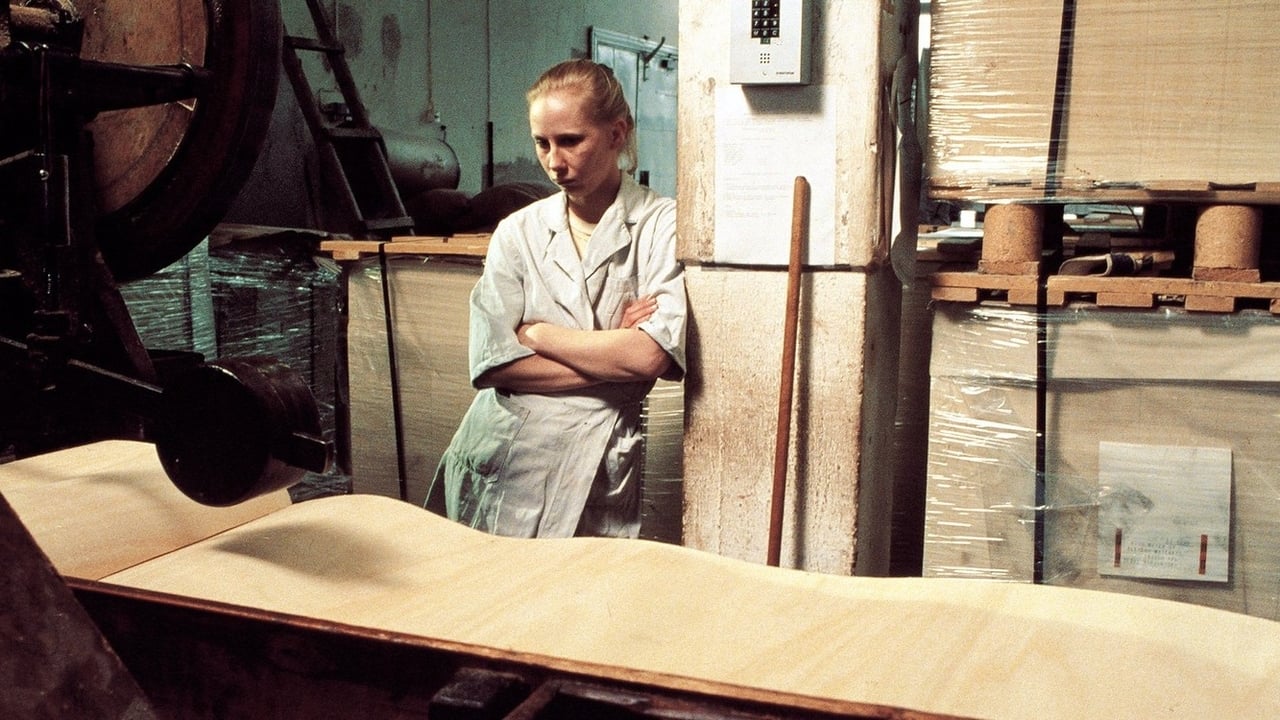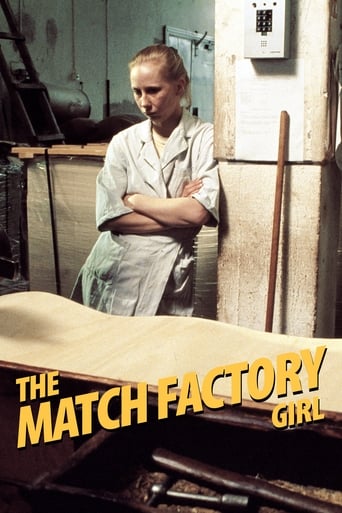

The opening of The Match Factory Girl, the first few minutes, doesn't feature the actress Kati Outinen, who is the Girl of the title Iris - instead Kaurismäki shows us how matches are made. This sounds like it could be deathly dull, but the way it's shot and edited you see the process of it, and it's all completely impersonal. No matter what the machine keeps rolling along, stripping the wood from trees into tiny little pieces of wood that people use to make fire. I think it's important that we don't see Iris at first, and when we do first see her face it's the second shot following her hands. She could be anybody, another faceless person working at the machine that keeps on making these matches, the monotony of it, how it's so impersonal that actually having things like dreams or happiness wouldn't do much at all.This is an example of such a low-key "slice of life" narrative that is all about the banality of life and then, as it turns out, the sort of banality of evil (though there's initially a good reason for this person becoming). What leads someone, who has a pretty safe if not very equitable day job, to poison a bunch of people? Iris doesn't really have much or many prospects, and she lives in a world that is full of grays. This isn't to say the palette of the camera is gray (this isn't like Children of Men or something), but all of the objects, the buildings, the rooms, the clothes, it's a nation made out of dreary, hopeless things. So when Iris does something like, say, buy a dress to make herself slightly more attractive, her father slaps her for her gall (and for not, you know, immediately giving any extra money she has to the family).But I wonder if that added color is almost a disrupter of its own, to the aesthetic that people are comfortable with. This is a film that is quite brief - barely 68 minutes - and yet it tells a complete narrative, slim as it is, by showing us this simple chain of events: girl meets boy, boy tells girl to go away, girl is knocked up, girl asks for help, boy rejects girl, girl gets her vengeance. But this is not some exciting movie or even some piece of exploitation trash like I Spit on Your Grave (thank goodness). This is more in debt to Bresson - and later I'm pretty much certain was what Soderbergh watched before making Bubble, which I don't like anywhere near as much as this - where it's all about how people have this lack of humanity, it's repressed, it's all tucked down deep, and yet the filmmaker is deeply human and caring about the people in his line of sight.Outinen's performance is fascinating for how she does a lot with so little. Just her sitting in bed, her eyes say a lot about her present mental state, or when she cries during a movie (what movie is it, why is it making her cry, who knows, it's a movie and an escape/release for her emotions), and of course how she can show hurt without being really BIG with her emotional register. In other words this suffuses what could be a basic melodrama by making it about how she is raised in this world of the dreary and gray, but the rest of the outside world - seemingly another galaxy - has a lot worse problems (i.e. Tieneman square is brought up in a broadcast on the news, not necessarily dating it as you could put any disaster in its place) - and music is often shown her as modern or hard or rough (the original version of "Brand New Cadillac" comes at a crucial point on a jukebox).It's certainly not a movie for everyone; it moves slowly, and the director and editor cut it in such a way that shots linger longer than you may be used to. But stick with it and you'll find that it's a rather troubling and startling movie about what it means to be a part of the "working class", and a woman, without many real rights or prospects. Not exactly a happy movie, and the way it ends with its multiple murders is startling (I wondered where it came from, but honestly it's besides the point), and it's essential in a way of understanding the malaise and repetition of many people in the modern world.
... View MoreI found this film to be delightfully minimalistic, Iris' innocence is completely shattered by the harsh reality of life as she grows into a woman.I thoroughly enjoyed this film and it has definitely become one of my favorites, the exploration of a working class girl who is expected to provide for her parents and receive nothing in return is expertly done. The minimal dialog and focus on the dreariness of Iris' working class life is a very effective narrative.Iris is a simple working class woman who has simple working class desires, she searches for a partner in life and love only to be at first rejected, the chewed up and spat out by a cold unfeeling upper class middle aged balding man.When life gives us lemons most of us hope that there is something better out there, we try to improve ourselves even through the harshness and selfishness of our fellow human beings we see a light. Why do we do this? Iris refuses to answer this question, or even contemplate it.I recommend this film without hesitation, Enjoy!more reviews @ filmstvandlife.wordpress.com
... View MoreGood for me that I watched this film at home, so that I didn't bore myself to death with it, but could play solitaire (yes, it drove me to that). I didn't like the film because: -Finnish people are not as extremely quiet as depicted in this film, so don't get the wrong idea about this nice European nation. Was it trying to be artistic??? It was just plain boring. -Iris has a behaviour that I couldn't imagine any human being could have... She's a loser who accepts her faith, but suddenly she's had enough and kills others, instead of killing herself, which would have been the more credible ending. -During the whole one hour of the film I had permanently the feeling that nothing fits... nada, nix... like watching separate scenes from different movies put together. E nough said. My advice is: DO NOT waste an hour of your life with this film. IMDb rating does not reflect reality.
... View MoreIiris is not considered a beautiful girl (although I personally would protest against such a judgment), so whenever she goes to dance, she is the only one left alone by the dancers. She has to pay for her drink at the bar. At home, there is her mother and the mother's boyfriend, sitting around the whole day in cross-training-clothes (a very strange parallel between Finnish and Hungarian people), smoking, drinking vodka, watching television or what is going on outside the window. (Quite a situation which we see so often in Béla Tarr's early movies.) Iiris works in a match factory and supports both her mother and the mother's boyfriend with the money she makes. Moreover, in the evening, she washes and irons the clothes. When one day she buys her a new sexy dress, the mother's man calls her a whore and tells her to bring the cloth back so that he has more to live from it during this month. Already at this point, the most patient watcher would whack out, but Iiris carries her grief with herself alone. However, one evening, she meets a man in her bar, they dance, they drink, they go to his expensive looking apartment. When she awakes in the morning, she finds a money bill on her nightstand. When she knocks at his door a few days later, he refuses to let her in. When she finds out that she got pregnant, a few weeks later, she gets a one-sentence notice by typewriter from him saying: "Get rid of it" - together with a check destined to an abortionist.But thanks to the non-existing god in this world of the Helsinki suburbs, Iiris is not Brecht's "Heilige Johanna Der Schlachthöfe". She enters a pharmacy and buys a good-sized package of rat poison. She chooses a nice little bottle, where she fills the lethal mixture of dissolved rat poison and goes first to the bar. Like an inverted female Jesus Christ at the Last Supper, she pours with an angel-like face a good slug of poison in the innocent-looking man's whiskey glass. And so, she goes on, from station to station, not like Federspiel's "Tiffoid Mary" an essentially unknowing killer-medium, but wholly determined Kaurismäki's "Rat Posion Iiris", a sweet-looking female death on her Danse Macabre.
... View More